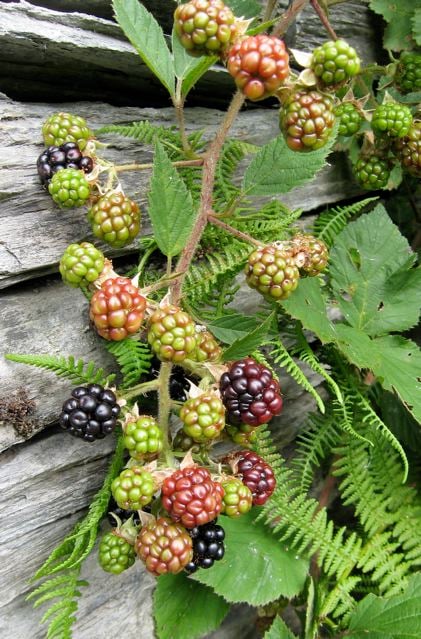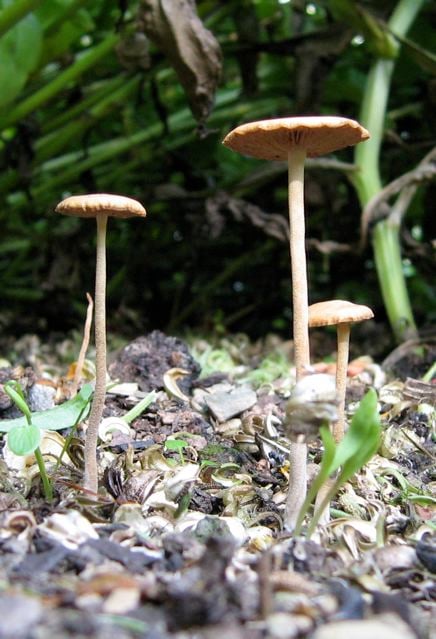Step back, let live, and try a little gardening on the wild side. A laid-back approach has all sorts of benefits – starting with more time to enjoy it all.
One of my growing resolutions this year was to do less in my garden. I’ve kept this quiet up until now: most resolutions we make quickly lose their power and promise once they’re broadcast. By less, I don’t mean doing less work, but doing less fussing, being less controlling of things, and putting the stops on less often. Some of my garden, including my greenhouse, is now ‘grown up’ enough to have an emerging spirit of its own. The garden’s still under my overall guidance, but it’s gaining a wild, unpredictable edge. This is an edge that, if you let it be, brings all sorts of unexpected rewards, both for us and for the life we share our patches with.

I have tried (and failed) for several years to finally plant a raspberry bed, so my summer fruits still come from the wild canes growing around my garden. Although wild raspberries quickly form impenetrable thickets, this year I fought a flaring desire to pull them up. Selfishly, I longed for their tiny fruits, which no cultivated cousin can match for flavour. Selflessly, I let them be just for the hordes of small bumblebees which set the canes vibrating for weeks as they busied themselves on the flowers. Easing up here tasted good (their autumn colour is not bad either, though I suspect they might be long gone by then).
Whereas pulling up wild raspberries demands a thick pair of gloves, wild brambles (blackberries) require full body armour. Hence I never quite got around – mid-heatwave – to uprooting the thorny triffid that’s invading a corner of one of my beds. And it’s turned out to be a blessing: I’ve been beguiled by butterflies, moths, hoverflies and bees of every order feasting on its insect-alluring flowers. Better still, today my greedy fingers are stained delicious purple – reward enough to offset the scratches across my calves. The pollinating posse did good elsewhere, triggering a good set on my now prolific runners. Stepping back here paid off.
But it’s not just me that’s getting fat as I ease up on pulling and digging up ‘unwanted’ stuff. Alongside the bramble a self-sown silver birch is staking a claim, although its days there are numbered (I’ll relocate it in winter). At one point its sappy shoots were encrusted in aphids, drawing much attention from hoverflies. A week or so later the sap-suckers were being ploughed through by fat, lurching hoverfly larvae which gobble them up. My greenhouse has been alive all summer with darting hoverflies, which have laid their own eggs among the aphids encamped on my climbing beans, tomatoes and peppers. Tiny parasitoid wasps are working alongside them, injecting their lethal eggs into aphids, which turn tell-tale brown as they’re eaten alive from inside. You won’t find unfolding ‘wildlife drama’ like this on any TV screen, but it’s free-to-view once you ease your finger off the sprayer’s trigger.
As well as pest-eaters that actively track down aphids and other bugs, I’m glad to be able to put a glass roof over our most underrated allies: spiders. Although the relocation programme is a gentle one come glass-washing time (brush softly into a container and rehome), I’ve retired the feather duster and now welcome the intricate silk traps that are spun all around my greenhouse. Whether they’re big, full-on webs slung between the glazing bars, capable of snaring a cabbage white, or the humble, sheet-like efforts of money spiders draped between tomato leaves, all are welcome. Clumps of Tagetes ‘Lemon Gem’ and other flowers enticing to insects guarantee them a varied menu. The ‘do less’ tip here is to stop obsessing about out-of-reach nooks and crannies (no matter what scrub-scrub-scrub advice you might read) and leave them to the eight-legs.

My two- and four-legged garden co-habitants are also getting plenty out of my ‘do less’ resolve. As I was acquiring my purple-stained fingers, the heat and humidity hit a perfect August note, launching a plume of red flying ants into the air, and into the beaks of nearby pied flycatchers and higher-altitude swifts. The common lizards and slow worms (I know, they have no legs) must have thought they’d hit the fast-food jackpot; they love to bask on the flat pieces of slate I’d untidily left lying around, and the ants found those perfect for nesting under. Note to self: pile up more slate in sunny spots on the bank and invoke amnesia.
Ants might be fast food above ground, but there’s a slow food revolution of sorts going on underground in my garden beds, and in my pots. Fungi usually mean trouble; I’m entering the late summer ‘grey mould zone’ in my greenhouse, when warm, humid days trigger the spores of botrytis. We tend to treat more obvious ‘mushrooms’ growing near plants with equal (and often justified) trepidation, but flushes of small toadstools this summer have got me having a fungal rethink. First they came up in my pot-grown strawberries: delicate, small grey caps that wouldn’t carry a fairy’s weight, and lived just a day. It took courage not to embark on a frenzied ‘save them’ repotting session, but as the plants seemed in perfect health with fattening flower buds (and a tap-out revealed roots to die for), I settled, toes crossed, for fretting less.
After several more flushes of tiny toadstools, they duly flowered – profusely – and gave the best berries ever, for nigh on a month. I know that some peat-free composts can grow strong, healthy plants, but those with bark in their mix seem able – aided by some clearly friendly fungi – to impart extra magic. Similar toadstools have popped up in the home-made compost I’m growing my tomatoes in, and they’re thriving. Casting my instinctive fungal fears aside, and just seeing what happened, was a good call.

So when small, somewhat sturdier toadstools started to appear in the leafy shade among my vegetables during the last week, I was laid back. My soil is being built up slowly using leaf mould, garden compost and occasional green manures. I don’t dig it now, and disturb it as little as possible. The beds where toadstools are showing have been mulched in the past with fine, composted bark, which has now worked down into the soil. Bark again: it did good things to my strawberries, and it seems to be doing the same for my runner beans, carrots and potatoes. No need for fungicides or fretting about ‘changing the soil’ (phew).
My quiet, guarded resolution has paid off in ways I couldn’t have predicted. My stepping back a little has allowed nature to step forward. It’s reminded me of what a powerful ally nature can be, and it’s been full of surprises. I could quite get used to all this easing up a little, to letting things be – at least for a while. That said, my blackberry-stained fingers won’t last long and, with juicy fruits just a memory, it’ll be time to don the body armour…
Text and images © John Walker


